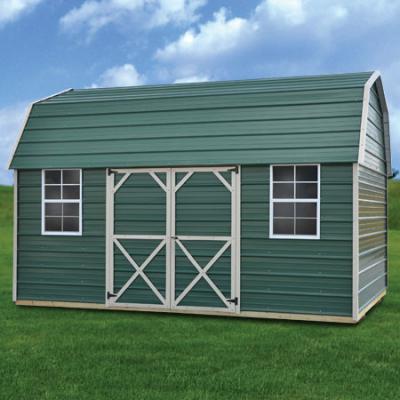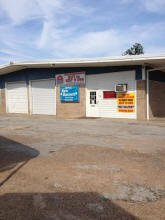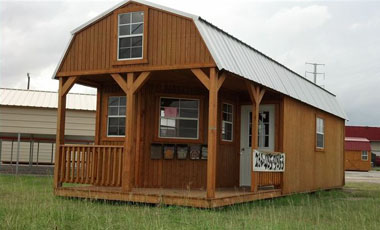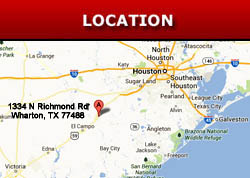Wharton Portable
Buildings Richmond,
Texas

Richmond,
Texas City Website
Richmond,
the county seat of Fort Bend
County, is on the Brazos River
fifteen miles southwest of
Houston. The city's
transportation links include
U.S. highways 90A and 59, the
Southern Pacific Railroad, and
the Atchison, Topeka, and Santa
Fe Railway. In early 1822 a
group of twelve to fifteen men
led by William W. Little camped
in the vicinity of the present
city and were soon followed by
other members of Stephen F.
Austin's Old Three Hundred. A
log fort built at the bend in
the Brazos River became the
nucleus of a settlement, which
came to be known as Fort Bend,
or the "Fort Settlement." The
community was evacuated in 1836
during the Runaway Scrape. In
early 1837 the town of Richmond
was established by Robert Eden
Handy and his business partner,
William Lusk, and as early as
April the partners were
advertising to sell lots in the
town. Named after Richmond,
England, the town was first
incorporated by the Republic of
Texas in May 1837; in December,
when Fort Bend County was
formed, Richmond became its seat
of government. In January 1839 a
Methodist Episcopal church was
organized, and in April the
town's first newspaper, the
weekly Richmond Telescope and
Texas Literary Register, began
publishing.
The town's early residents
included some of the best known
Texans of the period, including
Erastus (Deaf) Smith and Jane
Longqv; Mirabeau B. Lamar lived
on a plantation within the
present limits of the city. By
1851 Richmond included a brick
courthouse, two stores, a
Masonic Hall, the Methodist
church, and the Richmond Male
and Female Academy. A yellow
fever epidemic swept through
Richmond in 1853, but its future
seemed assured in 1855, when the
Buffalo Bayou, Brazos and
Colorado Railway extended its
tracks into the town. By 1859
the town was a prosperous
shipping and market center for
the area's cotton plantations
and had grown to include a
cotton warehouse and two hotels;
a brick building for other
stores was also being built.
Though a number of men from
Richmond and the surrounding
area joined Confederate
companies during the Civil War
and the local economy declined,
in other ways the town itself
remained largely isolated from
the conflict. After the end of
the war, many emancipated slaves
from surrounding plantations
began to move into Richmond's
environs; in 1866 an agency of
the federal Freedmen's Bureau
was established at Richmond, and
in 1867 a company of federal
troops were stationed there.
Allied with white Republicans,
the area's blacks controlled
local politics until 1889, when
whites in the area seized
control after the
Jaybird-Woodpecker War.
Before the Civil War Richmond
became a center of the "cattle
empire" that grew between the
Brazos and Colorado rivers;
cattle were branded on ranges
just west of the town before
being sent north to market
centers in the Midwest. In 1878
the Gulf, Colorado and Santa Fe
Railway extended its tracks
through the area but bypassed
Richmond; a new, rival community
called Rosenberg was built on
the railway three miles from the
old town. In 1884 2,000 people
lived in Richmond. That year,
along with the courthouse and
four churches, the town had a
bank, sugar mills and
refineries, and six schools.
Cotton, corn, livestock, hides,
sugar, and molasses were being
shipped from the town. A wooden
bridge across the Brazos was
built at Richmond about 1888,
and when that collapsed five
years later it was replaced by a
sturdier steel structure.
Nevertheless, partly because of
competition from Rosenberg and
other new towns growing in the
county at that time, Richmond's
population dropped to 1,500 by
1890 and 1,180 by 1904. An
enormous flood surrounded the
town in 1899. Richmond's economy
remained dependent on
agriculture until the 1920s,
when oil production began in the
county.
By 1934 there were eight
producing oilfields and a sulfur
mine within an eight-mile radius
of the town. During the 1930s
sidewalks were extended through
much of the town, and a large
municipal pool was built;
Richmond's citizens also
approved a bond package that
funded a number of other civic
improvements, including a new
city hall, a modern water
system, and new fire-fighting
equipment. Though local
agricultural production suffered
during the Great Depression, the
surrounding cotton growers still
supported two large cotton gins
in Richmond, and the town also
had a large irrigation pumping
plant that supplied water to
rice fields in the area. Despite
the improvements, a traveler
passing through the town in the
1930s still thought Richmond's
"fine old white frame residences
of the plantation type" gave the
town "the air of the Deep
South." The town's population
rose from 1,273 in 1920 to 1,432
by 1930, and to 2,026 by 1940.
Beginning in the late 1940s
people began moving to the
Richmond-Rosenberg
area to commute to jobs in
Houston, and the trend
intensified during and after the
1950s. As a result the town's
population grew rapidly, rising
from 2,026 in 1950 to 3,668 by
1960, to 5,777 by 1970, and to
9,692 by 1980. As Richmond and
Rosenberg grew together the
towns increasingly cooperated in
development and planning
projects.
By 1990 there were 9,801 people
living in Richmond. The
population reached 11,081 in
2000. In 2010, the U.S. Census
stated the population for the
City of Richmond to be
approximately 11,600. Historic
points of interest in Richmond
include the Morton Cemetery, the
1883 John Moore Home, the
Long-Smith Cottage, the
McFarlane Visitors Center, the
historic county courthouse, many
historic homes, a Confederate
Museum, and the Fort Bend
Historical Museum. |































